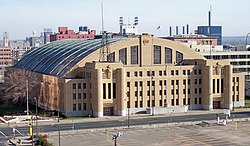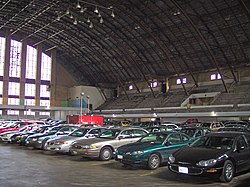Minneapolis Armory
Minneapolis Armory | |
U.S. National Register of Historic Places | |
 The Minneapolis Armory in 2006 | |
 | |
| Location | 500–530 6th St., S. Minneapolis, Minnesota |
|---|---|
| Coordinates | 44°58′30.33″N 93°15′47.8″W / 44.9750917°N 93.263278°WCoordinates: 44°58′30.33″N 93°15′47.8″W / 44.9750917°N 93.263278°W |
| Area | 2.5 acres (1.0 ha) |
| Built | 1935–36 |
| Architect | P.C. Bettenburg; Walter H. Wheeler, |
| Architectural style | PWA Moderne |
| NRHP reference No. | 85002491[1] |
| Added to NRHP | 26 September 1985[2] |
The Minneapolis Armory is an 8,400-person capacity music and events venue located at 500 South 6th St. in Downtown Minneapolis, Minnesota, United States. The Armory was built for the Minnesota National Guard in 1935–36 and also used by the Minneapolis Lakers of the NBA from 1947-1960. It was listed on the National Register of Historic Places in 1985.[2]
In 2015, the Armory was purchased by a local development firm for $6 million.[3] The building was converted from a parking facility to an 8,400-capacity[4] events center and concert venue.[5] It reopened in January 2018 in time to host several events related to Super Bowl LII.
History[]
The armory was the costliest single building in Minnesota supported by a Public Works Administration grant. The building is an example of the PWA Moderne style, a design characterized by strong geometry, bold contouring and integrated sculpture ornamentation.[6] The building was designed by St. Paul architect P.C. Bettenburg, who was also a major in the Minnesota National Guard.[7] St. Paul artist Elsa Jemne painted murals in the building.[8]
From the late 1930s through the 1970s, it was a venue for civic events, including concerts, political conventions and sporting events such as Golden Gloves tournaments. The building was used by the Minneapolis Lakers of the National Basketball Association as a part-time home between 1947–1959,[6] and as its primary home court for the 1959–60 NBA season.[9][10] Professional motorcycle racing took place inside the Armory during the winter months from 1968 through 1980. The National Guard was still operating at the armory in 1985.[6]

Hennepin County bought the armory in 1989 for $4.7 million, with plans to place a new county jail on the site.[7] The Minnesota Historical Society sued to stop its destruction and in 1993, the Minnesota Supreme Court ruled that the structure was protected by state law and could not be torn down because of its historical status.[11] In 1998, the county sold the building for $2.6 million to a private company for use as a parking structure on condition that it be preserved.[6]
In popular culture[]

Minneapolis native Prince used the building to shoot the music video for "1999" in 1982.[12]
In 1998, Aerosmith recorded the video for I Don't Want to Miss a Thing there.[13]
See also[]
- List of Registered Historic Places in Minnesota
References[]
- ^ "National Register Information System". National Register of Historic Places. National Park Service. July 9, 2010.
- ^ a b Nord, Mary Ann (2003). The National Register of Historic Places in Minnesota: A Guide. St. Paul, Minn.: Minnesota Historical Society Press. p. 95. ISBN 0-87351-448-3.
- ^ Painter, Kristen Leigh. "Armory in downtown Minneapolis sold to developer who plans events venue". Star Tribune. Retrieved 2 July 2015.
- ^ Uren, Adam. "Deadmau5 announces concert at The Armory in Minneapolis". Bring Me the News. Retrieved 31 May 2018.
- ^ Black, Sam. "Ned Abdul buys Minneapolis Armory, plans entertainment center". bizjournals.com. Minneapolis/St Paul Business Journal. Retrieved 2 July 2015.
- ^ a b c d Hennepin County Fact Sheets: Archived 2006-10-23 at the Wayback Machine Minneapolis Armory[permanent dead link]
- ^ a b Millett, Larry (2007). AIA Guide to the Twin Cities: The Essential Source on the Architecture of Minneapolis and St. Paul. Minnesota Historical Society Press. p. 75. ISBN 0-87351-540-4.
- ^ McGlauflin, ed., Who's Who in American Art 1938–1939" vol.2, The American Federation of Arts, Washington, D.C., 1937 p. 274
- ^ Thornley, Stew (1989). The History of the Lakers : Basketball's Original Dynasty. Minneapolis, Minn.: Nodin Press. p. 68. ISBN 0-931714-39-7.
- ^ Gustavo, Solomon (September 7, 2016). "The Armory: Remains of Minnesota sporting glory". MinnPost.
- ^ Millett, Larry (2007). AIA Guide to the Twin Cities: The Essential Source on the Architecture of Minneapolis and St. Paul. Minnesota Historical Society Press. p. 66. ISBN 0-87351-540-4.
- ^ "1999". princevault.com. Retrieved 26 June 2020.
- ^ Boller, Jay (28 July 2017). "Minneapolis Armory to re-emerge as massive event space". CityPages. Retrieved 26 June 2020.
External links[]
 Media related to Minneapolis Armory at Wikimedia Commons
Media related to Minneapolis Armory at Wikimedia Commons- Official website
- Armories on the National Register of Historic Places in Minnesota
- Art Deco architecture in Minnesota
- Basketball venues in Minnesota
- Former National Basketball Association venues
- Installations of the United States Army National Guard
- Government buildings completed in 1936
- Minneapolis Lakers venues
- National Register of Historic Places in Minneapolis
- Public Works Administration in Minnesota
- PWA Moderne architecture
- Sports venues in Minneapolis
- 1936 establishments in Minnesota
- Event venues on the National Register of Historic Places in Minnesota
- Sports venues completed in 1936
- Music venues in Minnesota
- Tourist attractions in Minneapolis



